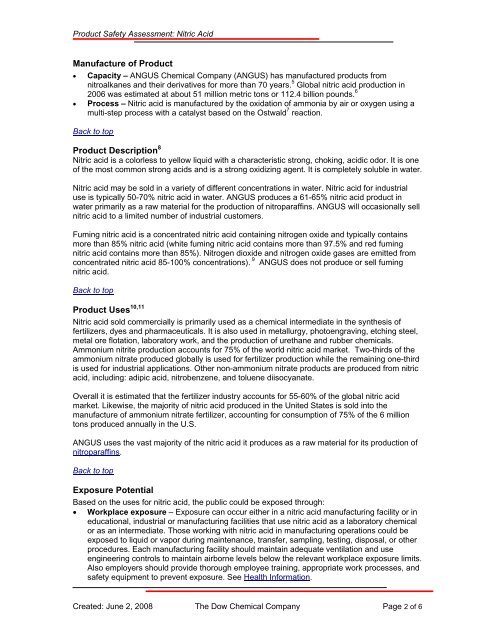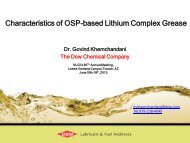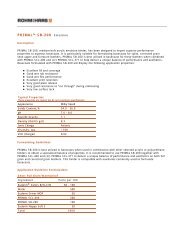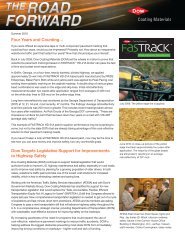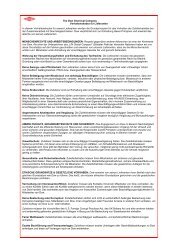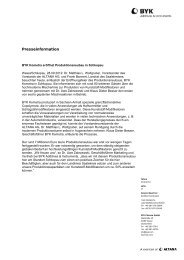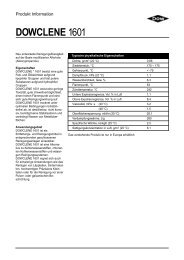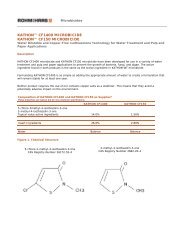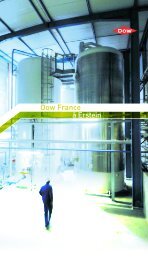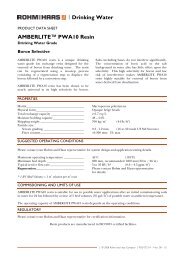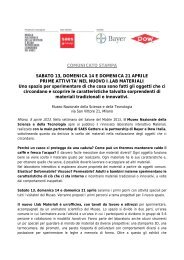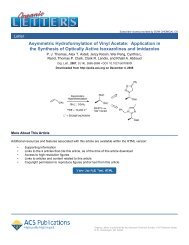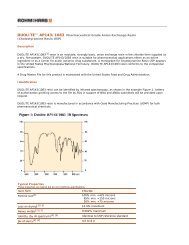Product Safety Assessment Nitric Acid - The Dow Chemical Company
Product Safety Assessment Nitric Acid - The Dow Chemical Company
Product Safety Assessment Nitric Acid - The Dow Chemical Company
You also want an ePaper? Increase the reach of your titles
YUMPU automatically turns print PDFs into web optimized ePapers that Google loves.
<strong>Product</strong> <strong>Safety</strong> <strong>Assessment</strong>: <strong>Nitric</strong> <strong>Acid</strong><br />
Manufacture of <strong>Product</strong><br />
• Capacity – ANGUS <strong>Chemical</strong> <strong>Company</strong> (ANGUS) has manufactured products from<br />
nitroalkanes and their derivatives for more than 70 years. 5 Global nitric acid production in<br />
2006 was estimated at about 51 million metric tons or 112.4 billion pounds. 6<br />
• Process – <strong>Nitric</strong> acid is manufactured by the oxidation of ammonia by air or oxygen using a<br />
multi-step process with a catalyst based on the Ostwald 7 reaction.<br />
Back to top<br />
<strong>Product</strong> Description 8<br />
<strong>Nitric</strong> acid is a colorless to yellow liquid with a characteristic strong, choking, acidic odor. It is one<br />
of the most common strong acids and is a strong oxidizing agent. It is completely soluble in water.<br />
<strong>Nitric</strong> acid may be sold in a variety of different concentrations in water. <strong>Nitric</strong> acid for industrial<br />
use is typically 50-70% nitric acid in water. ANGUS produces a 61-65% nitric acid product in<br />
water primarily as a raw material for the production of nitroparaffins. ANGUS will occasionally sell<br />
nitric acid to a limited number of industrial customers.<br />
Fuming nitric acid is a concentrated nitric acid containing nitrogen oxide and typically contains<br />
more than 85% nitric acid (white fuming nitric acid contains more than 97.5% and red fuming<br />
nitric acid contains more than 85%). Nitrogen dioxide and nitrogen oxide gases are emitted from<br />
concentrated nitric acid 85-100% concentrations). 9 ANGUS does not produce or sell fuming<br />
nitric acid.<br />
Back to top<br />
<strong>Product</strong> Uses 10,11<br />
<strong>Nitric</strong> acid sold commercially is primarily used as a chemical intermediate in the synthesis of<br />
fertilizers, dyes and pharmaceuticals. It is also used in metallurgy, photoengraving, etching steel,<br />
metal ore flotation, laboratory work, and the production of urethane and rubber chemicals.<br />
Ammonium nitrite production accounts for 75% of the world nitric acid market. Two-thirds of the<br />
ammonium nitrate produced globally is used for fertilizer production while the remaining one-third<br />
is used for industrial applications. Other non-ammonium nitrate products are produced from nitric<br />
acid, including: adipic acid, nitrobenzene, and toluene diisocyanate.<br />
Overall it is estimated that the fertilizer industry accounts for 55-60% of the global nitric acid<br />
market. Likewise, the majority of nitric acid produced in the United States is sold into the<br />
manufacture of ammonium nitrate fertilizer, accounting for consumption of 75% of the 6 million<br />
tons produced annually in the U.S.<br />
ANGUS uses the vast majority of the nitric acid it produces as a raw material for its production of<br />
nitroparaffins.<br />
Back to top<br />
Exposure Potential<br />
Based on the uses for nitric acid, the public could be exposed through:<br />
• Workplace exposure – Exposure can occur either in a nitric acid manufacturing facility or in<br />
educational, industrial or manufacturing facilities that use nitric acid as a laboratory chemical<br />
or as an intermediate. Those working with nitric acid in manufacturing operations could be<br />
exposed to liquid or vapor during maintenance, transfer, sampling, testing, disposal, or other<br />
procedures. Each manufacturing facility should maintain adequate ventilation and use<br />
engineering controls to maintain airborne levels below the relevant workplace exposure limits.<br />
Also employers should provide thorough employee training, appropriate work processes, and<br />
safety equipment to prevent exposure. See Health Information.<br />
Created: June 2, 2008 <strong>The</strong> <strong>Dow</strong> <strong>Chemical</strong> <strong>Company</strong> Page 2 of 6


